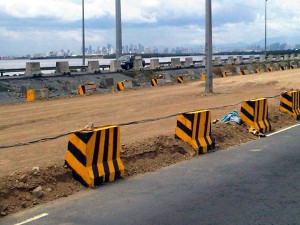Philippines surprises with 7.1% GDP growth in Q3; more jobs, better incomes seen

The Coastal Road from the Pasay end of Roxas Boulevard to Cavite province is upgraded in this photo taken on May 13, 2012. The Philippines beat expectations in the third quarter with 7.1 percent growth in terms of gross domestic product, ahead of other economies within Association of Southeast Asian Nations. PHOTO BY RICK ALBERTO
MANILA, Philippines—The Philippines beat expectations in the third quarter with 7.1 percent growth in terms of gross domestic product (GDP), ahead of other economies within Association of Southeast Asian Nations. The country’s top economist said this would translate to more jobs and better incomes for Filipinos.
The third-quarter performance of the Philippines was way above the market’s media forecast of 5.4 percent, Socioeconomic Planning Secretary Arsenio Balisacan said. Indonesia was the second-best performer in the Asean with 6.2 percent growth, followed by Malaysia (5.2 percent), Vietnam (4.7 percent), Thailand (3 percent), and Singapore (0.3 percent). On the other hand, China registered a 7.7-percent GDP growth in the same period.
Balisacan said he expected economic growth momentum to continue in 2013 as government has been working to ease the cost of doing business and as more infrastructure projects go into construction, spurring dollar inflows that might help ease the strengthening peso.
Year-to-date growth is already at 6.5 percent with services and industry (except mining) still driving growth. Officials said this meant that full-year growth would likely beat the target of 5 to 6 percent and move towards the previously “aspirational” 7 to 8 percent range needed per year to spur employment and curb poverty.
A strong BPO (business process outsourcing) sector, booming construction, increased consumer and government spending, and external trade contributed to the highest quarterly growth since the third quarter of 2010, National Statistical Coordination Board (NSCB) Secretary-General Jose Ramon G. Albert said.
Article continues after this advertisementRelatively stable prices, steady inflow of remittances, and rebounding exports supported growth, according to the National Economic and Development Authority (NEDA). While export receipts of semiconductors and electronic data processing equipment contracted, both items contributed recently to increased imports, which might mean that manufacturers have been “stocking up” on intermediate inputs in anticipation of recovery in the global demand for electronic products, NEDA said.
Article continues after this advertisementProperty development due to growing demand for homes and office spaces (mostly due to a strong BPO outlook) helped push development, NEDA said, as did public road and irrigation projects. “Most of these (government) projects were implemented outside NCR, in keeping with our objective of inclusive growth,” Balisacan said.
Agriculture also fared better in the third quarter than in the four previous quarters with increased rice and corn outputs as part of efforts for food self-sufficiency. The weak fishery sector has become a concern, however, Balisacan said.
Trade Secretary Gregory Domingo said in a phone interview that he was “not surprised” with the 7.1 percent growth for the third quarter because the country was coming from low growth base. In the third quarter of 2011, the economy turned sluggish as exporters and other contributors to the economy felt the impact of the triple tragedy in Japan and the flooding in Thailand earlier that year.
“Nevertheless it is good to post this level of growth for the third quarter. We will continue to help our business people with shared facilities, simplifying and shortening the process of starting a business, and educate entrepreneurs as well as students on how to take advantage of free-trade agreements.
The Makati Business Club (MBC) lauded the strong third-quarter performance. “MBC and the larger business community welcome yet another positive development for the Philippine economy despite continuing global challenges. Good governance is paying off. President Aquino and his economic team must be lauded,” MBC executive director Peter Perfecto said via text message.